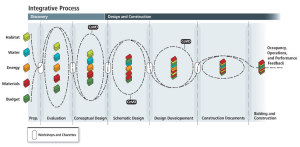Recently, the Project Managers at Lorax have been driving some project teams to pursue the LEED v4 IP Credit Integrative Process as a v2009 Pilot Credit. The credit seems to capture the essence of what LEED has been trying to do since its inception, creating cost-effective and sustainable outcomes through discipline collaboration.
The Integrative Process credit includes an early water and site analysis, but the most daunting part of this credit is running an early, “Simple Box Model.” Turns out, the idea of running a Simple Box Model during the Concept or Schematic Design phase scares the pants off of most project teams!
A Simple Box Model is not nearly as elaborate or difficult as it sounds, we promise (that’s why they put “Simple” in the name)!
A Simple Box Model only requires very basic information about the building, and therefore can be run quickly without much work. What is the gross square footage of the building? Where could the building be located on the site? What is the basic shape and geometry of the building? Iterations of the model are then run based on different basic design options and compared to one another. There is no need for comparison to a theoretical baseline building or standard like ASHRAE 90.1-2007 or 2010, but rather contrast between alternate designs.
The Simple Box Model allows the energy modeler to find out what the actual Energy Use Intensity (EUI) is for any basic design decision. It can help answer questions like, “Will the building use more energy if we locate it in the shady area of the site, or in the sunny area of the site?” with a definitive answer based on data rather than assumptions. Once the optimal EUI is determined, the appropriate HVAC system can be selected and sized appropriately.

Source: The Integrative Design Guide to Green Building – Redefining the Practice of Sustainability by 7group and Bill Reed
This process also keeps different design disciplines from acting in a siloed fashion. By looking at the actual outcomes of different insulation options, for example, team members must work together to make the best selection.
The Simple Box Model essentially allows the building to act as a process load before an HVAC system is even selected. The box model permits teams to optimize buildings through decisions on site conditions, massing and orientation, basic envelope attributes, lighting levels, thermal comfort ranges, plug and process load needs, and programmatic and operations parameters. Major decisions can then be based on energy usage before other deciding factors are brought to the table.
As any proponent of the integrative process would support, the Simple Box Model really requires the energy model (and iterations of the energy model) to become a decision making tool, rather than just a documentation requirement for LEED. To learn more about the Simple Box Model, and the Integrative Process, check out the credit requirements, here on the USGBC website.
While the sustainability and green building industry grows and adapts, Lorax continues to adapt and learn in order to act as your most knowledgeable resource in the field. For more information and consultation on the Integrative Process or the Simple Box Model as well as any other green building rating system, please contact us here.
References: The Integrative Design Guide to Green Building – Redefining the Practice of Sustainability by 7group and Bill Reed and Leadership in Energy & Environmental Design Reference Guide for Building Design and Construction Version 4.

